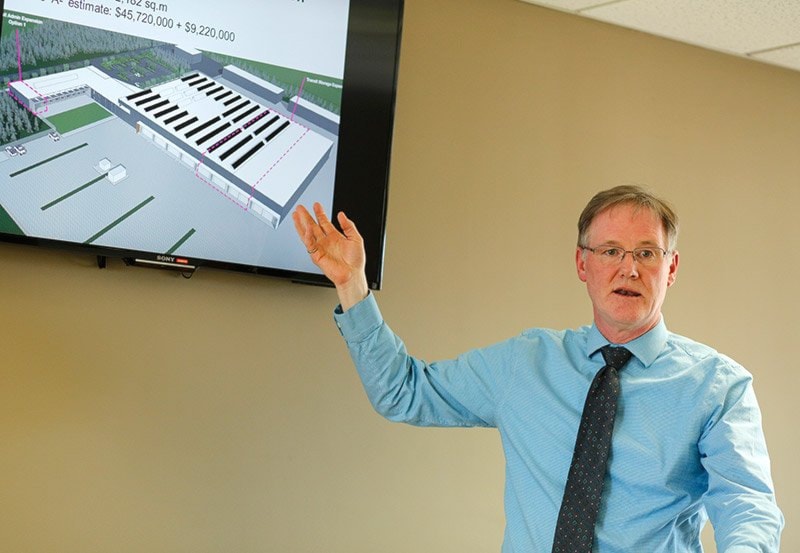Whitehorse city staff told council April 18 it can save $1 million if it approves a $9.2-million budget increase to the long-awaited plan for the new operations building.
The transit building is one of the nine city offices meant to be merged into the operations building over the course of a five-year plan.
The savings come from doing the work now instead of later, as the current transit building is not meeting the city’s needs, said Wayne Tuck, the city’s engineer.
Adding the transit expansion now also saves money through “economies of scale and production,” said Peter O’Blenes, director of infrastructure and operations.
“They’re buying more concrete, more steel, they have more buying power,” he said.
The current transit building, located in the Marwell area, is not big enough to house all of the city’s 13 full-length buses and two accessible buses at the same time, said Tuck.
This causes problems in the winter, because buses stored outside must be left idling all night to ensure they will start in the morning, he said.
The new addition to the operations building plan adds administration facilities, space for mechanics and a four-bay garage, which will be able to house 17 full-size buses and three accessible buses, Tuck said.
The building would also house other heavy equipment, such as graters, front-end loaders and garbage trucks, O’Blenes said.
“This building is key to ensuring we give our operators the equipment they need when they go out,” he said.
The original plan for the operations building was estimated to cost $45.7 million. With the transit expansion, the pre-tender estimate is $55 million, but $8.6 million of the additional $9.2 million would be paid for by funding from the federal gas tax, said O’Blenes.
However, the gas tax funding has not yet been approved by the territory. O’Blenes said they are “99 per cent confident the gas (tax) funding will come through.”
“(The) bus expansion totally applies to the gas tax rules … we’re confident the money will be available,” he said.
If that funding did not come through, O’Blenes said the project would revert back to the original pre-transit expansion plan.
The city would have to front $600,000 from reserves because the gas tax would likely not cover the administrative costs of the expansion, O’Blenes said. It would not require additional borrowing.
The overall plan for the operations building, designed by Toronto-based firm RDHA, is designed to be “expandable” to meet future needs and to be as energy efficient as possible, O’Blenes said.
The new operations building exceeds the 2011 national energy code’s efficiency standards by 80 per cent, Tuck said. It includes an array of solar panels on the roof, which will meet some of its energy needs. It will be propane heated with an electric boiler, with provision for biomass in the future.
Estimates of annual operating costs for the new building are not complete, O’Blenes said, but he anticipates the savings to the city will be about $100,000 a year.
The other option is to renovate the existing transit building at a cost of $620,000, Tuck said. This would only be a temporary “stop-gap” measure, he said, especially because mechanics would not be housed in that building. This would mean buses would have to be shuttled back and forth for maintenance and repairs.
“Even if we renovated the transit building it wouldn’t address the issue of the mechanics being up the hill,” Coun. Roslyn Woodcock said. “Sometime later on, we would be building a transit expansion no matter what.”
Mayor Dan Curtis agreed, adding that even if the addition were built, it might “be fine for a year … but we’d still have great big diesels idling outside in the winter.”
There will be no tax increase with this part of project, O’Blenes said.
Overall, the project would see the city spend $12.2 million from its reserves and $23.8 million from the federal gas tax.
It would also have to borrow $18.8 million, doubling the city’s current debt limit. This represents a “significant,” net increase in the debt load, said Valerie Braga, the city’s chief financial officer.
“This is going to be the most significant decision in the city’s history and affect taxpayers for the next 20 years,” Coun. Samson Hartland said. “To say that there are no alternatives is not truly the case. We have a number of options to look at.”
“I’m all into listening to all the facts and all the reasoning but I just don’t see an alternative to the nine other buildings that have lived their life and are done,” said Curtis.
Council will vote April 24 on whether to put the project to tender with the requested transit expansion.
Hartland said he felt there should be a second vote to increase the debt limit, but if council “has to make a decision lock, stock and barrel next week, then (they) will.”
If approved, a contract would be awarded by mid-July, O’Blenes said.
Contact Lori Garrison at lori.garrison@yukon-news.com
